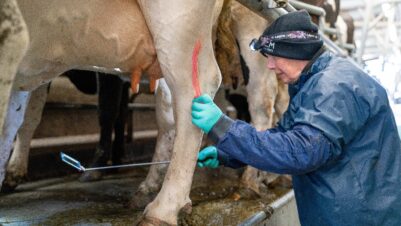An episode of familial Shar-Pei fever (FSF) may show nothing more than pyrexia, with temperatures from 39.4 to 41.7°C, which last 24 to 36 hours and go back to normal without treatment. However, about half the affected dogs have swollen hocks, recognised as swollen hock syndrome (SHS), and there may be additional signs such as a swollen muzzle, abdominal pain, reluctance to move, an arched back, vomiting, diarrhoea and rapid breathing. Wrinkled skin is normal in Shar-Pei hocks; it must be accompanied by pyrexia and inflammation of the joint or the skin for a diagnosis of SHS. These episodes usually occur before the dog is 18 months old and attacks are likely to become less frequent as the dog becomes older.
Shar-Pei dogs affected by FSF have high resting levels of interleukin-6 (IL-6), the cytokine which plays a central role in COVID-19 pathology. As the inflammatory process develops, IL-6 and other cytokines trigger the production of acute phase reactant proteins, the precursors of amyloid AA.
In normal animals, the acute phase reactant proteins are produced in the acute phase of the inflammatory process and broken down and excreted once their function is over. However, where the IL-6 levels stay high the acute phase reactant proteins accumulate as the tough, insoluble folded proteins recognised as amyloid. Amyloid deposits occur outside cell walls, in blood vessels and in many organs. The worst effects for the Shar-Pei are when deposits form in the kidneys. Amyloidosis may progress slowly or quickly, taking from months to years to show as renal failure. So, as in some cases of COVID-19, the inflammatory process goes wrong and increases the tissue damage instead of eliminating the original pathology.
FSF appears to be an autosomal recessive condition which occurs in about 25 percent of Shar-Pei dogs. It is not known whether a single gene is to blame or several. It seems likely that heterozygous carriers may have episodes of FSF with or without SHS but they do not suffer the chronic renal failure (CRF) which leads to an early death, while homozygous animals do develop amyloidosis and CRF and usually have FSF as well. FSF episodes indicate that a dog is at high risk of developing amyloidosis. Some clinicians recommend starting treatment at this point even though not every FSF case will progress to amyloidosis.
Amyloidosis usually centres on the kidneys but sometimes involves the liver. It is most often found in dogs between three and eight years old but has been seen from eight months to 12 years of age. Diagnosis is confirmed from histological samples taken by renal biopsy or at post-mortem.
The clinical picture is the mainstay of diagnosis for FSF with bloods mostly normal, perhaps showing an elevated white cell count with a left shift and a raised alkaline phosphatase. Proteinuria and low urine specific gravity are warning signs of medullary amyloid deposition; these are likely to occur later in the disease process and must be treated as progressive renal failure. A screening routine of haematology, biochemistry and urinalysis should be carried out annually in any dog which has experienced FSF and any stud dog or potential breeding bitch. If tick-borne diseases such as Lyme disease are a problem locally these should be ruled out and each case should be investigated as indicated by the individual’s problems.
As FSF is self-limiting the mainstay of treatment is close observation and temperature taking. Non-steroidal anti-inflammatory drugs can be used to reduce the pyrexia and relieve pain. In a few cases the condition may require emergency fluid therapy and intensive care. FSF is very rarely fatal but the subsequent amyloidosis shortens the dog’s life. Many clinicians start treatment with colchicine after the first episode of FSF. Colchicine is an antimitotic alkaloid derived from the plant Colchicum autumnale which is also known as autumn crocus, more familiar as the source of saffron. Colchicine is toxic if overdosed but it has been around for a long time: it is used to treat gout and familial Mediterranean fever (FMF). Colchicine damps down the inflammatory response by stopping neutrophil chemotaxis, and reducing the expression of adhesion molecules and the production of reactive oxidative species and cytokines. It reduces mast cell degeneration and has the end product of preventing amyloid deposition. This is the key to preserving life.
Glucocorticoids inhibit the production of hyaluronan, the mucopolysaccharide that is found in the intercellular substance of many tissues, including the skin, where it is the foundation of the Shar-Pei wrinkles. Steroid therapy will reduce a dog’s wrinkles while it is reducing the inflammatory response which is mediated by damaged hyaluronan. It can be used topically or at intermittent low doses.
FSF has a parallel condition in humans. Familial Mediterranean fever (FMF) usually starts in childhood, is characterised by recurrent bouts of fever and polyserositis, is self-limiting and is an inherited autosomal recessive condition. As with FSF, colchicine is used prophylactically to prevent early death from amyloidosis.











